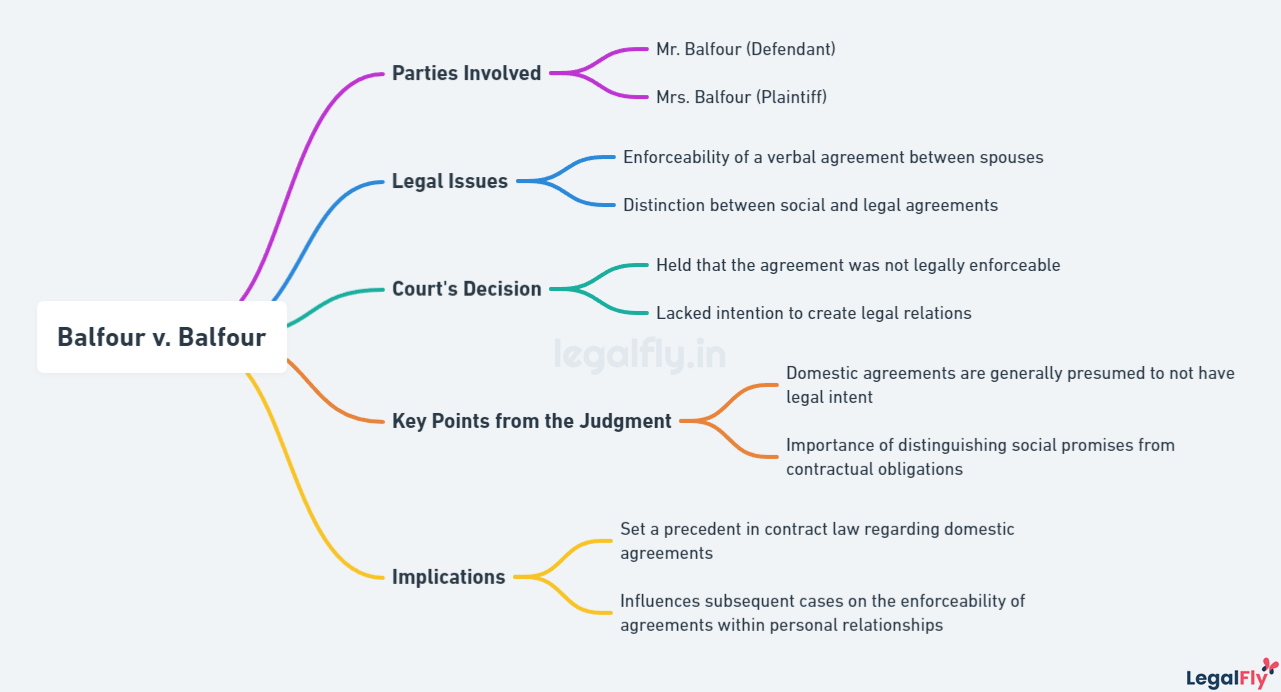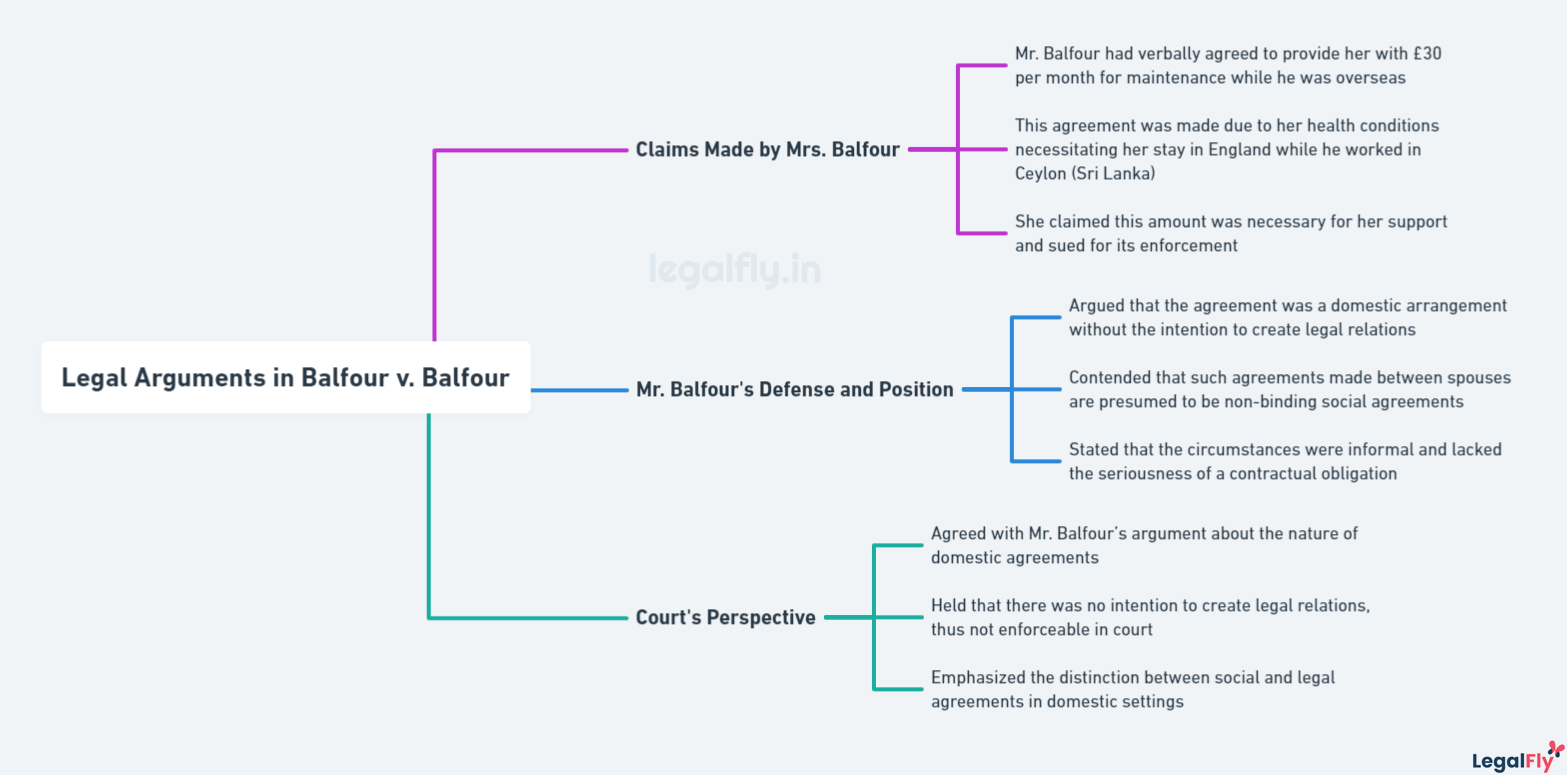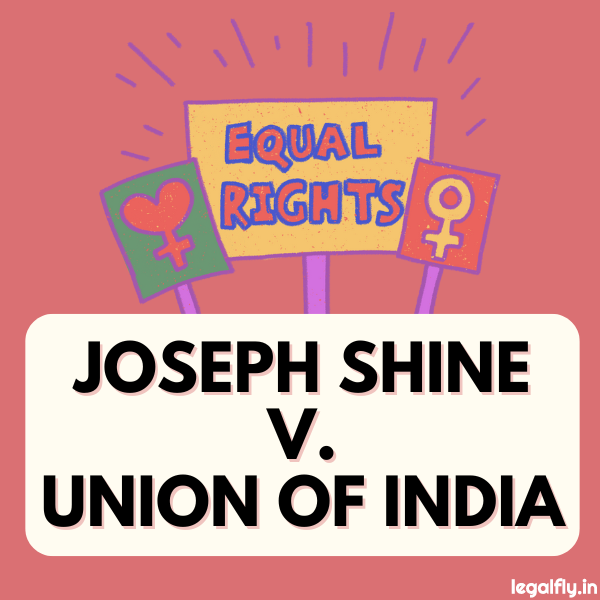Case Name: Balfour v. Balfour
Court: Court of Appeal, England
Year: 1919
Citation: [1919] 2 KB 571
Table of Contents
Introduction to Balfour v. Balfour
Balfour v. Balfour is a landmark 1919 English contract law case on domestic agreements between spouses. The case involved a husband who worked overseas and promised to send his wife maintenance payments but later stopped paying when the couple separated.
The key facts of Balfour v. Balfour are:
- The plaintiff, Mrs. Balfour, and the defendant, Mr. Balfour, were a married couple living in Ceylon (now Sri Lanka) in 1915.
- Mr. Balfour worked in Ceylon, while Mrs. Balfour lived in England due to health reasons.
- Mr. Balfour promised to send Mrs. Balfour £30 monthly as maintenance while they were separated.
- The couple later separated, and Mr. Balfour stopped sending the payments.
- Mrs. Balfour sued for breach of contract, arguing there was an enforceable agreement.
- Mr. Balfour argued there was no intent to create legal relations between spouses.

The main issue was whether an agreement between husband and wife to pay maintenance created a legally binding contract. This case established the presumption that domestic agreements generally do not demonstrate an intention to be legally binding.
Context and Background of the Dispute
The dispute in Balfour v. Balfour centered around a domestic agreement between a married couple, Mr. and Mrs. Balfour. In 1915, Mr. Balfour, who worked as a civil engineer, was posted to Ceylon (now Sri Lanka) for Government Service. His wife was unable to accompany him due to health reasons.
Before his departure, Mr Balfour promised to pay his wife £30 a month until they were reunited. For a while, he kept his promise and made the monthly payments. However, in 1917, the couple’s relationship deteriorated, and Mr Balfour stopped sending the payments.
Mrs Balfour brought a breach of contract claim against her husband, arguing that his failure to pay the monthly £30 allowance constituted a breach of a legally binding agreement between them. Mr Balfour maintained that it was a domestic arrangement rather than a formal contract. This set the stage for the legal dispute to be resolved in court.
The case highlighted issues around whether informal domestic agreements could be considered legally enforceable contracts. At the time, there was no clear legal precedent on the intention required to form binding contracts between spouses. This background led to the dispute in Balfour v. Balfour coming before the courts.
The Claims Made by Mrs. Balfour
Mrs. Balfour argued that the agreement between her and her husband constituted a legally binding contract. She claimed that when her husband left for Ceylon, he agreed to send her £30 a month to cover her living expenses while they were separated. This agreement was made orally between husband and wife before Mr. Balfour departed in 1915.
Mrs. Balfour contended that all the elements of a valid contract were present – offer, acceptance, consideration and intention to create legal relations. The offer was Mr. Balfour’s promise to pay her a monthly allowance, which she accepted. She considered that she would stay in England while her husband worked abroad.

Furthermore, Mrs. Balfour asserted that both parties clearly intended to create legal relations. The agreement was severe in nature, not just a domestic arrangement, and the specified monthly sum gave the contract a commercial character. She argued the contract was not dependent on the continuation of the marital relationship.
Therefore, Mrs. Balfour claimed that her husband had breached this legally binding agreement by failing to pay her the agreed allowance after April 1917. She sought damages for this breach of contract as she could not support herself without the payments.
Mrs. Balfour’s arguments relied on establishing that a domestic agreement between spouses could be intended to have legal consequences and be enforceable by law. This challenged the prevailing notion that social agreements were not legally binding contracts.
Key Legal Principles Established
The Balfour v. Balfour case established important legal precedents that significantly impacted English contract law. The main principles established were:
- The presumption that domestic and social agreements between spouses are not intended to be legally binding contracts. The court ruled that there was insufficient evidence that Mr. and Mrs. Balfour intended their maintenance agreement to be legally enforceable. This created a default assumption for similar domestic arrangements going forward.
- The introduction of the doctrine of intention to create legal relations. Following Balfour v. Balfour, courts began examining whether the parties in an agreement intended it to have legal consequences. This doctrine became a crucial part of determining contractual validity.
- The onus is placed on the party asserting that a domestic agreement is legally binding to prove the intent to create legal relations existed. The court determined Mrs. Balfour had not sufficiently shown Mr. Balfour meant the agreement to be legally enforceable when made. This precedent meant the burden of proof now fell on the party seeking to make the contract legally binding.
- Courts should consider the broader context and circumstances when assessing intent for domestic agreements. The fact Mr. and Mrs. Balfour were married was deemed highly relevant by the court in presuming there was no intent for legal relations. This indicated context should help determine intent.
Overall, Balfour v. Balfour significantly shaped the legal framework for distinguishing between social and legally binding agreements. The precedents from the case continue to influence contract law today.
The Doctrine of Intention to Create Legal Relations
One of the key legal principles established in Balfour v. Balfour was the doctrine of intention to create legal relations. The court ruled that there was no intention between Mr. and Mrs. Balfour to create legal relations when making their agreement.
The doctrine establishes whether a court should presume that parties to an agreement wish it to be enforceable at law. It states that an agreement is only legally binding if the parties intend it to be.
Lord Justice Atkin reasoned that the agreement between husband and wife was a “domestic arrangement” made for reasons of preserving marital cohesion. It was not meant to have legal consequences outside of the marriage.
This established the precedent that agreements in domestic and social settings are assumed to lack an intention for legal relations. The onus is on the party claiming there was intent to prove it.
Balfour v. Balfour reinforced the rebuttable presumption that domestic agreements between spouses do not carry legal obligations. This presumption can only be overcome with evidence showing both parties meant for it to be a formal contract.
The case clarified this doctrine and cemented the view that informal promises, especially between family members, are not usually binding contracts unless actively demonstrated otherwise.
Repercussions for Domestic and Social Agreements
The ruling in Balfour v. Balfour had significant repercussions for domestic and social agreements between spouses. The court established a rebuttable presumption that domestic agreements were not intended to create legal relations.
This meant that agreements between spouses for housekeeping allowances or living arrangements were presumed to be non-legally binding. The onus was placed on the party seeking to enforce the domestic agreement to prove that legal relations were intended.
However, this presumption could be rebutted with evidence showing an intention to create legal relations. Factors like written documentation of the agreement could help demonstrate legal intent. However, informal verbal agreements were unlikely to be enforced.
Overall, Balfour v. Balfour made it much harder to legally enforce informal domestic agreements between spouses. It reinforced the separation between commercial contracts and family arrangements. Critics argued it deprived wives of legal protections for domestic promises. However, it shaped contract law’s view that intimate agreements generally lack contractual intent.
Legal Criticisms and Praise
Balfour v. Balfour has received both criticism and praise from legal scholars over the years. Some key analyses include:
- The ruling has been criticized as going against the basic principles of contract law by creating an arbitrary exception for domestic agreements. By denying the enforceability of a clear promise, it undermines the sanctity of contracts.
- However, supporters argue the court was practical in recognizing the realities of marital relationships and avoiding judicial interference. Enforcing domestic promises could flood courts and harm families.
- Feminist scholars contend the case perpetuated patriarchal norms by leaving married women financially vulnerable. But others say it protected privacy.
- Overall, Balfour is praised for elucidating the intent to legally bind as key to contracts. But it draws criticism for its gendered legacy. Its wisdom is still debated today.
Lessons for Legal Professionals and Students
Balfour v. Balfour provides several critical lessons for legal professionals and law students studying contract law. The case highlights the importance of establishing a clear intention between parties to create legally binding relations when entering into domestic and social agreements.
One of the main takeaways from Balfour v. Balfour is understanding the presumption against contractual intention in domestic and social arrangements. Lawyers drafting agreements between spouses or family members should be aware of this presumption and take care to expressly document the legally binding nature of the agreement. Students should recognize that informal promises between family or friends are generally not enforceable in court, absent evidence of real contractual intent.
Additionally, the case illustrates the need for offer, acceptance, consideration and an intention to create legal relations as key elements in forming an enforceable contract. Students must grasp these essential requirements and how the courts analyze whether a valid contract exists based on each dispute’s specific facts and evidence.
The case of Balfour v. Balfour provides a valuable lesson on the importance of contractual intention and the complications that arise with informal domestic agreements. Legal professionals should guide their clients on formalizing such arrangements, while students can gain insights into interpreting issues of contract enforceability.
Summary of Balfour v. Balfour’s Legacy
Balfour v. Balfour is a landmark case in English contract law that established the legal presumption against creating binding agreements in domestic situations. The case has significantly impacted how domestic agreements are treated in contract law.
The key legacy of Balfour v. Balfour is that it created the legal precedent that domestic and social agreements are not intended to be legally enforceable contracts. This presumption meant that informal promises between spouses or family members would not be binding in a court of law.
The case influenced many subsequent legal decisions involving domestic agreements. Courts have frequently applied the principles from Balfour when determining the enforceability of agreements made in a personal or domestic context. The presumption against contractual intent remains an important part of modern contract law.
Overall, Balfour v. Balfour cemented the separation between legally enforceable contracts and informal domestic promises. The case continues to stand for the legal position that intimate agreements should not be subject to the same standards as commercial contracts. This legacy shaped contract law’s treatment of domestic arrangements between spouses and family members.




